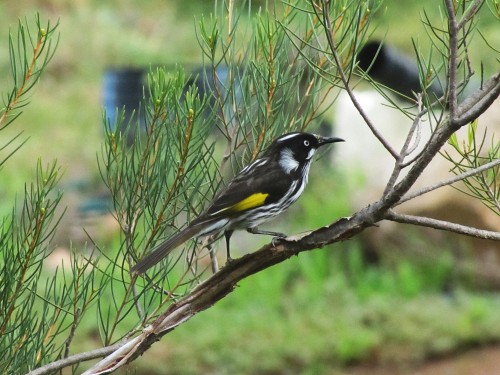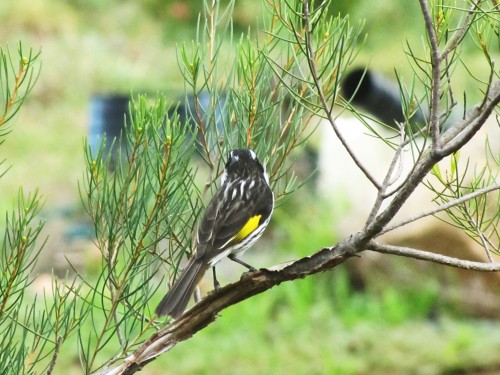New Holland Honeyeaters
Sometimes everything just works really well when taking photos of birds.
Here is a case in point.
I looked out of the window from my office and saw this New Holland Honeyeater perched on one of the branches of a bush in the garden. I grabbed my camera and clicked; I was quite pleased with the result.
Sometimes you do win them.
Flying Black Kite, Mannum
A skill I admire in nature photographers is getting great still photos of moving birds or animals. It’s something I am still very much a novice at and will need to practise much more to get it right.
While this photo of a Black Kite soaring over the Murray River at Mannum taken a few weeks ago is not brilliant, I’m still quite pleased with it. Mind you, it has had a little treatment on my computer to enhance certain elements.
Click on the image to enlarge.
Fan-tailed cuckoo, Balranald
Sydney Trip June 2011
While having lunch on the banks of the Murrumbidgee River in Balranald last June, I saw a Fan-tailed Cuckoo quietly feeding in a nearby group of trees. I crept as close as I dared, trying not to scare it away. Eventually I was able to get this somewhat fuzzy photo – it’s not brilliant, but it’s the best of a bad lot. That’s what happens when one pushes one’s camera to it’s limit.
The Fan-tailed Cuckoo is a species I haven’t seen all that many times, so any any sighting is a good one. One day I shall also get a good photo.
Now here’s a common sight in Australia
Sydney Trip Report June 2011
Grain storage silos are a common sight throughout the cereal growing areas of Australia. Almost every small town has some and they make up a prominent feature of the landscape. On our trip to Sydney earlier this year we passed many such structures along the way. They become so commonplace one almost forgets that they are there.
Not me.
I usually give silos more than a quick glance as they flash by, checking out each one for any interesting birds perching on the building or flying nearby. Sadly I’m usually disappointed because the most common inhabitant of these artificial “cliffs” are Rock Doves (feral pigeons), usually in their hundreds. Quite often they are in the company of just as many House Sparrows.
On the odd occasion, however, I have seen Nankeen Kestrels, Black-shouldered Kites, flocks of Galahs and Corellas and even cockatoos. At Lameroo I only managed to see some Rock Doves (see photo below). It’s not a brilliant photo, but considering the silos were some 200 or more metres away, the zoom on my camera is impressive.
Sometimes one has to be content with the common, ordinary species and a not so wonderful photo.
A cold, almost non-birding experience
On the last leg of our recent holiday to Yorke Peninsula we stopped briefly at the Hale Conservation Park between Williamstown and Mt Pleasant in the Adelaide Hills. It was late afternoon, cloudy, occasional showers and bitterly cold. We stopped for a quick snack and a cup of tea – to warm us up.
As we pulled up and emerged from the car, the surrounding bushland was quiet – too quiet. I not only couldn’t see any birds, there seemed to be a total silence from the resident bird life. I’ve only ever experienced this on one of two occasions before. I’ve found that almost anywhere one stops on rural roads in Australia, there will be at least some birds to be seen and/or heard. One one memorable occasion some years ago when I was gathering data for the Atlas of Australian Birds I had to submit a blank sheet; no birds in a 20 minute period. Mind you, it rained heavily during the period concerned so I was pushing the limits.
After a few frustrating – and cold – minutes waiting for something to call or appear, a small group of White-throated Treecreepers came into the car park and starting searching the bark on surrounding trees in their normal behaviour. Treecreepers and Sittellas always fascinate me with their ability to hop up and down and even underneath the trunks and branches of trees. Why don’t they sometimes fall off??
I had my camera ready, but the poor light conditions so late on a cloudy day meant I was pushing the limits trying to get photos. I would like to have used the flash, but they were too far away for that. The photos are not brilliant; they are the best I could achieve in the conditions.








